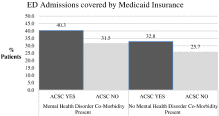Association of mental health disorders and Medicaid with ED admissions for ambulatory care–sensitive condition conditions☆☆☆★
Affiliations
- Denver Health Emergency Medicine Program, Denver Health Medical Center, Denver, CO
Correspondence
- Corresponding author at: Department of Emergency Medicine, Denver Health Medical Center, 777 Bannock St, Denver, CO 80204.

Affiliations
- Denver Health Emergency Medicine Program, Denver Health Medical Center, Denver, CO
Correspondence
- Corresponding author at: Department of Emergency Medicine, Denver Health Medical Center, 777 Bannock St, Denver, CO 80204.
Affiliations
- Biostatistics and Informatics, Colorado School of Public Health, Aurora, CO
Affiliations
- Department of Emergency Medicine, University of Colorado School of Medicine, Aurora, CO
 Article Info
Article Info
To view the full text, please login as a subscribed user or purchase a subscription. Click here to view the full text on ScienceDirect.

Fig. 1
Insurance status by presence of MHD and ACSC.
Abstract
Introduction
Adult Medicaid enrollees are more likely to have mental health disorders (MHDs) than privately insured patients and also have high rates of emergency department (ED) visits for ambulatory care–sensitive conditions (ACSCs). We aimed to evaluate the association of MHD and insurance type with ED admissions for ACSC in the United States.
Methods
We conducted a cross-sectional study of ED visits made by adults aged 18 to 64 years using the corrected 2011 National Emergency Department Survey. Using multivariable logistic regression analysis, we controlled for sociodemographics and clinical variables to determine the association between insurance type, MHD, Medicaid, and MHD (as an interaction variable) and ED admissions for ACSC.
Results
There were 131 million ED visits in 2011; after exclusions, 1.4 million admissions were included in our study. Of all ED visits, 44.7% had an MHD, of which 49.9% were covered by Medicaid and 38.1% were covered by private insurance. A total of 32.6% (95% confidence interval, 32.5%-32.7%) of ED admissions were for an ACSC. Medicaid-covered ED visits were more likely to result in ACSC hospital admission (odds ratio, 1.32; 95% confidence interval, 1.30-1.35) compared with visits covered by private insurance. Among patients with MHD, those with Medicaid insurance had 1.6 times the odds of ACSC admission compared with those privately insured.
Conclusion
Among all ED admissions, patients covered by Medicaid are more likely to be admitted for an ACSC when compared with those covered by private insurance, with a larger association being present among patients with MHD comorbidities.
To access this article, please choose from the options below
Purchase access to this article
Claim Access
If you are a current subscriber with Society Membership or an Account Number, claim your access now.
Subscribe to this title
Purchase a subscription to gain access to this and all other articles in this journal.
Institutional Access
Visit ScienceDirect to see if you have access via your institution.
☆Dr Roberta Capp was supported by a Translational NIH K award.
☆☆C.B., E.J.C., and R.C. have no conflicts of interest.
★This research was presented at the Western SAEM Conference in Tucson, Arizona, on March 27, 2015, and the National SAEM Conference in San Diego, California, on May 14, 2015.
Related Articles
Searching for related articles..



